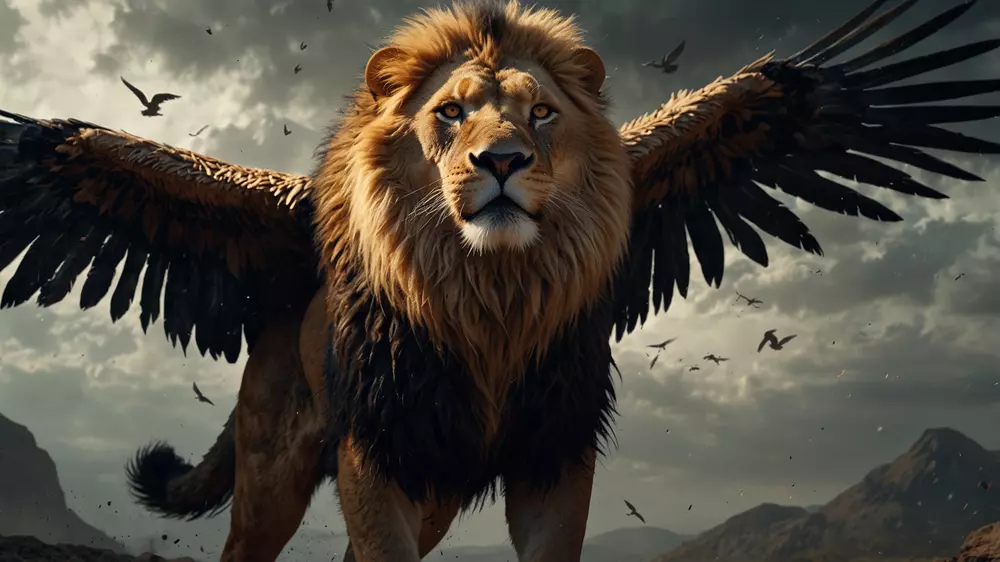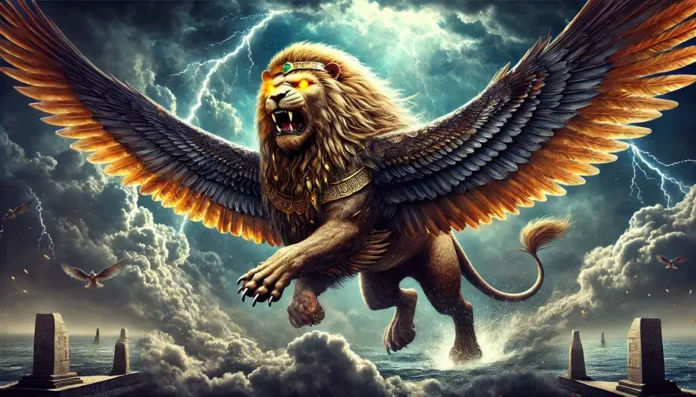Anzu: The Mythical Lion-Headed Eagle
Anzu, a powerful and iconic creature in Mesopotamian mythology, is often described as a giant bird with the head of a lion. This hybrid being embodies chaos and disorder while simultaneously symbolizing protection and divine authority. Anzu’s most famous tale involves the theft of the Tablet of Destinies from the god Enlil, a myth that reverberates through Sumerian, Akkadian, and Babylonian texts.
The mythological significance of Anzu is intertwined with ancient beliefs in cosmic order. Through this dramatic tale of betrayal and divine retribution, Anzu has been etched into the mythological fabric of ancient Mesopotamia as a figure of both rebellion and punishment. Over the centuries, this creature has influenced cultural practices, spiritual beliefs, and artistic representations, leaving a lasting impact on modern interpretations.
History/Origin
Anzu first appears in ancient Sumerian texts dating back to the third millennium BCE. This creature plays a critical role in the Sumerian myth Lugal-e, where the bird is described as stealing the Tablet of Destinies from Enlil, the chief god of the Mesopotamian pantheon. This tablet is said to contain the fate of all living things, and by stealing it, Anzu disrupts the divine order.
One of the earliest mentions of Anzu occurs in the Sumerian poem “The Myth of Anzu,” where Anzu is described as a gigantic creature residing in the mountains. The poem depicts him as a lion-headed eagle with enormous wings, which generate winds and storms when he flies. The Akkadian version of the myth, often cited from the library of Assurbanipal, elaborates on Anzu’s rebellion and his eventual defeat at the hands of the god Ninurta.

The myth recounts that after stealing the Tablet of Destinies, Anzu attempts to use its power to control the cosmos. The gods are thrown into chaos as Anzu’s act of treachery causes disorder across the universe. The god Ninurta is sent by the higher gods to retrieve the tablet, resulting in a monumental battle between Ninurta and Anzu. Ninurta’s victory restores order, and Anzu is slain, with the tablet returned to its rightful place. This myth reflects the ancient Mesopotamian belief in the importance of cosmic order and the divine right to rule.
Name Meaning
The name “Anzu” comes from the Akkadian word anzû, which can be translated as “strong wind” or “storm bird.” This name is reflective of Anzu’s association with weather and chaos, particularly his ability to generate storms by flapping his wings. In Sumerian, Anzu’s name takes on similar connotations, linking the creature to natural forces beyond human control. Some texts also refer to him as “Zu,” an abbreviated form found in several Akkadian versions of the myth.
Background Story
The story of Anzu centers on his theft of the Tablet of Destinies. In Mesopotamian belief, the gods governed the universe through control of this tablet, which dictated the fates of all beings. By seizing it, Anzu sought to overthrow the gods and seize control of the cosmos for himself.
The tale begins when Anzu, entrusted as a servant to the god Enlil, hatches a plan to steal the tablet during Enlil’s bathing ritual. After taking the tablet, Anzu flees to the mountains, disrupting the natural and divine order. The gods, powerless without the tablet, call upon Ninurta, the warrior god, to defeat Anzu and recover the sacred object.

The ensuing battle between Ninurta and Anzu is a dramatic display of divine power. Ninurta uses cunning and strength to eventually overpower Anzu, returning the tablet and restoring balance to the universe. Anzu’s downfall serves as a cautionary tale against defiance of divine authority and the chaos that ensues when the natural order is disrupted.
Cultural Impact
Anzu’s influence extends far beyond Mesopotamian mythology. In ancient Sumer and Akkad, Anzu was often invoked in rituals and prayers for protection against chaotic forces, particularly in contexts where weather or natural disasters were a concern. The stormy skies brought by Anzu’s wings were feared, but his role as a protector also led to his worship in some circles, particularly as a guardian figure in city gates and temples.
Throughout Mesopotamian culture, Anzu was depicted in numerous artistic forms. Stone carvings and reliefs often showed Anzu as a formidable lion-eagle hybrid, particularly in temple walls and palace gates. These depictions were meant to invoke his power and serve as symbols of both divine authority and the ever-present threat of chaos.
The Epic of Ninurta, where Ninurta defeats Anzu, became a popular narrative used during harvest festivals and religious celebrations. Through reenactments of the myth, participants would symbolically “defeat” the forces of disorder to ensure a prosperous harvest, underscoring Anzu’s role as both a disruptive and protective figure.
In religious practices, Anzu was associated with rituals that warded off natural disasters. His connection to storms and violent weather made him a figure of both reverence and fear. Offerings were made in hopes of pacifying Anzu’s chaotic influence, while prayers were offered to Ninurta to maintain the divine balance.
Scientific or Rational Explanations
Modern scholars often suggest that the legend of Anzu may have originated from real animals or natural events. Some believe that the depiction of Anzu as a gigantic bird could have been inspired by sightings of large raptors or eagles in the mountainous regions of Mesopotamia. These birds, with their enormous wingspans and predatory nature, may have sparked myths about powerful creatures controlling the skies.
Additionally, Anzu’s association with storms and weather may be tied to the natural phenomena of violent windstorms common in the region. These storms, capable of causing significant destruction, would have been perceived as acts of divine or supernatural forces, reinforcing Anzu’s role as a bringer of chaos.
In Modern Culture
The legend of Anzu continues to resonate in modern culture, appearing in various forms of media, literature, and entertainment. Here are five notable examples:
Final Fantasy Series
In the Final Fantasy video games, Anzu often appears as a powerful enemy. In these games, Anzu is depicted as a formidable flying beast with both magical and physical prowess, echoing its mythological role as a force of chaos.
Dungeons & Dragons
The influence of Anzu can be seen in many of the flying, lion-headed creatures that populate the Dungeons & Dragons universe. Anzu-like creatures serve as guardians or bosses in many campaign settings, reinforcing its legacy as both protector and destroyer.
Neil Gaiman’s American Gods
Anzu is referenced as part of the larger pantheon of forgotten gods in this novel. In American Gods, Gaiman uses Anzu as a symbol of the fading power of ancient deities, whose influence has waned in the modern world.
Godzilla: King of the Monsters (2019)
A creature resembling Anzu makes an appearance in this blockbuster film. Though unnamed, the creature’s design—a hybrid between a bird and a lion—suggests a clear influence from the myth of Anzu.
Magic: The Gathering
Anzu’s mythological themes of chaos and cosmic disruption are represented in various cards within the Magic: The Gathering universe. Certain creatures in the game mirror Anzu’s role as a bringer of storms and disorder, reinforcing its archetype in fantasy literature.

Anzu’s legacy endures, reflecting humanity’s ongoing fascination with creatures that straddle the line between order and chaos. Through literature, gaming, and film, Anzu’s myth continues to inspire and challenge modern interpretations of power, rebellion, and divine authority.
Conclusion
Anzu’s story is a timeless narrative of rebellion, chaos, and the restoration of order. From its ancient roots in Sumerian and Akkadian texts to its enduring presence in modern culture, Anzu remains a powerful symbol of the forces that challenge divine rule and cosmic balance. Whether feared as a bringer of storms or revered as a protector of sacred sites, Anzu’s place in mythology is as enduring as the winds that bear his name.





